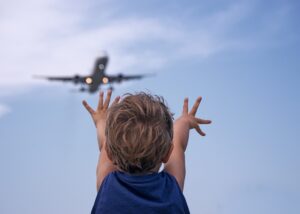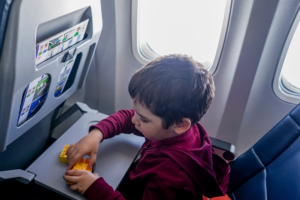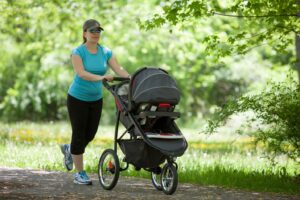If you’re traveling with your infant or child on a plane for the first time, it can be difficult to know what is the best way to keep them safe and comfortable throughout the flight. Different airlines and countries have different requirements for child restraint systems which can be challenging to understand. Until the age of 2, infants must sit on their parent’s lap during a flight, but there is also the option of using a child’s car seat. For infants under 2 and children over the age of 2, airplane car seats can enable the child to sit in their own seat alone safely.
This guide will give you everything you need to know about flying with car seat. We’ll take a look at when you can use them, how to use them, and what your other options are including checking in the infant car seat.
We aim to bring you some guidance on this topic to help your understanding but it’s important to remember that each airline has its own policy so it’s important to check with them directly regarding your flight and options.
We also discuss best FAA approved travel car seats and here’s a guide on flying with a stroller if you choose to bring one.
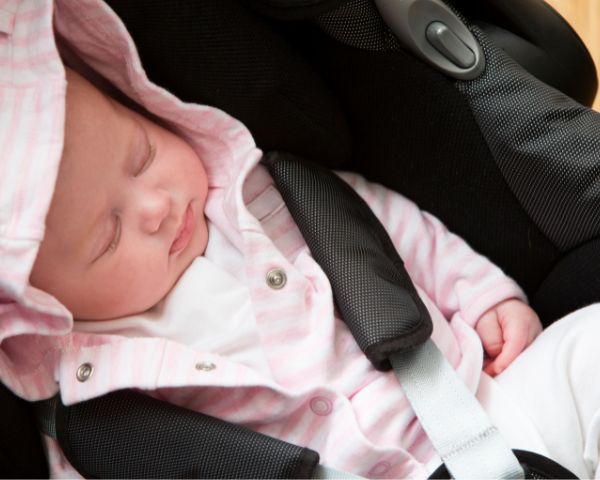
Can You Bring Car Seats on Airplanes?
You can bring car seats on most airplanes, but requirements vary between airlines and flights. Research has shown, and the FAA advises, that traveling with an infant airplane car seat is the safest way for an infant to fly because it provides them with their own seat and a better restraint than a parent holding the child on their lap. For that reason, many airlines, if not all, will require that the car seat is certified for air travel, either by the FAA or an equivalent air travel safety body.
Due to the size of the aircraft and seating arrangement, usually, car seats will not be allowed by the exit row, and the seats will need to fit within the size guidelines.
Infants under the age of 2 (for most airlines) are usually classified as a lap child and will need to sit on their parent’s lap for the duration of the flight. In some countries, an infant seat belt is required, but in others including the US and Canada, they have been banned. A convertible car seat that can also be used in flight can be used as an alternative and will provide the child with more safety. However, you will need to purchase a second seat for your lap infant.
Are Car Seats The Safest Way For Infants To Fly?
Car seats and child restraint systems are the safest way for infants to fly as opposed to flying on a parent’s lap. As mentioned above, research has shown this and the FAA advises this because it provides the best support. Let’s take a closer look at what the different safety bodies outline.
FAA – Federal Aviation Authority
The Federal Aviation Authority (FAA) advises that the safest way for an infant under the age of 2 to travel on a plane is with the use of an approved child restrain system (CRS), not on a parent’s lap. They explain this is because a parent’s arm is not a suitable restraint and cannot protect the child against unexpected forces such as turbulence. An FAA approved car seat provides this level of safety for a child, the same that an adult gets when they sit in a standard plane seat with a seat belt.
FAA approved car seats will have a certificate stamp of approval on the label so it’s important you check this. Do not cut out the label as you will usually be required to show this when boarding a flight if you are planning to use your car seat. The FAA also approves the use of AmSafe’s Child Aviation Restraint System (CARES). This is a device, specially designed for children who can sit upright on their own, who are up to 40 inches tall, and who weigh between 22 and 44 pounds.
EASA – European Aviation Safety Agency
The European Aviation Safety Agency (EASA) advise that infants under the age of 2 years need to be secured on their parent’s lap with a special infant safety seat belt. They advise that this is a necessity, but using a travel car seat is a safer alternative. The EASA support that infants using child car seats for flights provides the infant with the same level of protection that is offered to an adult sitting in their own empty seat.
There are different options of child car seats that can be used, such as forward-facing car seats, rear facing car seats (infants up to age 4), ISOFIX (a seat with a different type of seat attachment), and high-back booster seats (for children over the age of 5.)
ICAO – International Civil Aviation Organization
International Civil Aviation Organization (ICAO) provide similar guidelines to the FAA and EASA as they also advise that a child sitting in their own seat in a child car seat is the safest way for them to travel by air. A CRS (Child Restraint System) gives the child their own seat space and adequate protection which is not possible when a parent holds the child on their lap.
Infants and children are at a higher risk of sustained injuries and proper restrain during the flight can help reduce this. They explain the importance of only using certified and tested travel car seats for air travel as using seats that are not designed for aircraft can have detrimental effects on the impact during a collision or impact.
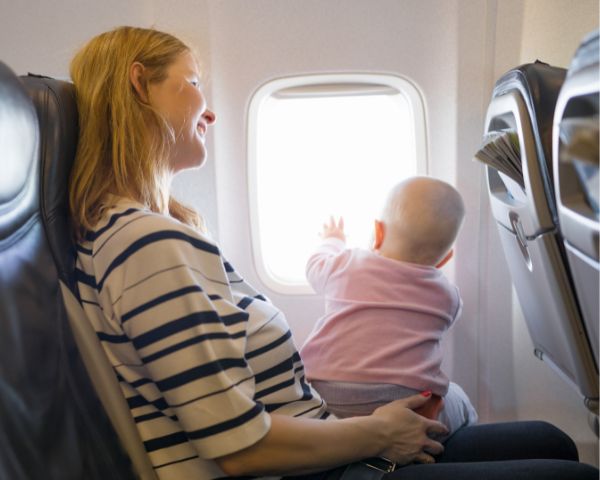
Why Aren’t Car Seats Mandatory?
Although car seats are the safest way for infants to fly, they are not a mandatory requirement on any flight. It’s still safe to hold your infant on your lap, but car seats provide additional protection.Car see ats are an expensive investment on top of the flight fees and purchasing an extra seat for your child. Due to this, car seats are not mandatory as it would make flying with an infant inaccessible for many families. It is your choice if you would like to use a car seat for extra safety, but it is not a mandatory requirement.
Do Car Seats Count as Checked Baggage?
Whether or not your car seats in included as checked luggage will depend on your airline and the flight. Ideally, you would be bringing your own car seat on the flight and using it to seat your infant. However, if the car seat isn’t approved for aircraft travel, it doesn’t meet the aircraft seat dimensions, or you do not want to purchase an additional seat then the car seat will not be coming on board the flight with you.
If you still need to take your car seat to your next destination, then you will need to put it in the hold with your checked baggage along with other items like your double stroller. Some airlines allow this as a free extra and in addition to your checked luggage allowance. Other airlines may charge an additional fee like you would pay if you were bringing additional baggage. This could also depend on the size and weight of your car seat, so you might want to consider a lightweight car seat if you want to reduce the price.
To find out if you can check the car seat in as checked baggage and if this will be an extra cost or not, get in touch with your airline for specific details.

Do Airlines Charge for Checking a Car Seat?
Sometimes airlines charge for checking in a car seat. It varies depending on the airline, flight, and ticket. You can refer to the Top 50 Airlines table to get an idea of whether or not your airline usually charges or not. Always contact the airline directly if you are unsure and be prepared to pay additional costs if they are required. If you have connecting flights or are flying with different airlines on your return, remember to check their policies as well as it will be a foreign government and rules differ.
What’s the Difference Between Checking In Your Car Seat vs Gate Checking Your Car Seat?
If you want to check in your car seat, there are two options: checking in at the ticket counter or checking in at the gate. Some airlines will give you both of these options, or usually the counter check-in only. We’ll explain what the difference is and you can check if your airline offers both.
Check-in Counter
You can check car seats in at the airport when you arrive, with your checked-in baggage. This means it won’t come with you through security and you won’t have it for the duration of your time in the airport. In many cases, this is required as your car seat will need to be put in the hold of the plane along with the baggage.
Check-in At Gate
In some cases, you can check car seats in when you arrive at the gate after you have gone through security. You can give the car seat to the gate agent to put your seat in the luggage hold. This may be needed if your car seat is not slim enough to fit within the airplane seat or if there is limited space for your car seat aboard the plane. Gate-checking your car seat also reduces the chances of damage due to fewer people handling the car seat.
This can be a preferable method as it means you will have the seat with you, but it also reduces the risk of your child’s car seat being damaged. It won’t need to be transported through the airport and packed with the rest of the luggage so will be handled more carefully.
If your car seat is being checked in at the gate, then it may be returned to you by the flight attendant when you disembark the plane, or it could be returned with the rest of the checked-in baggage at baggage claim. You can check with the flight crew about how to get your car seat back after the flight.
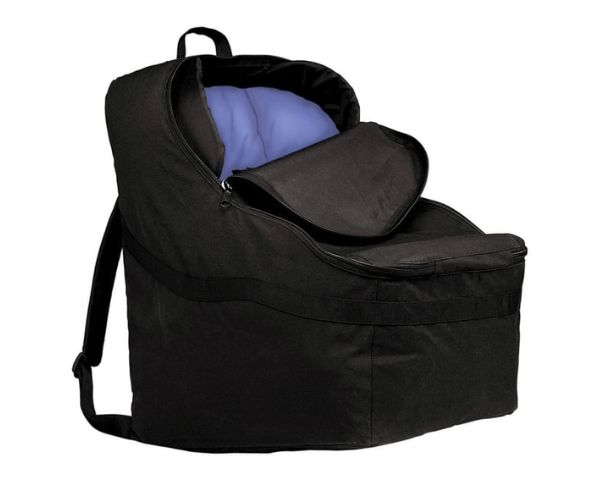
Are There Any Risks of Checking Your Car Seat?
Checking in your car seat comes with its own set of risks, some of which are the same risks you take when you check in your luggage. In some cases checking in your car seat is unavoidable but there are measures you can put in place to minimize the risk.
Car seat can be damaged
Car seats are designed to withstand impact, but after one collision you’d need to replace them. If the car seat is not handled with care when it is put on the plane, it could be damaged. Often airline baggage and freight handlers move quickly to pack and unpack bags, so one wrong movement and your car seat could be hit. Car seats can also get damaged when they are on the conveyor belt to get packed away, and at baggage claim if they were to fall off.
Car seat can be lost
Not all luggage returns from flights and this includes car seats. When you’re checking in your car seat and luggage before a flight, sometimes issues arise and the luggage doesn’t arrive at your next destination with you. This lost luggage could end up somewhere entirely different and difficult to track down.
Sometimes lost luggage returns but it could be weeks or months before you get your hands on it. If you needed the car seat after your flight then you could be at risk without one if it was to become lost. Although this isn’t a common occurrence, it still happens and is something to be prepared for.
There’s no safe way to restrain your child on the plane
If you check in your infant car seat then you won’t be using it for the duration of the flight. This means there’s no safe way to properly restrain your child on the plane as you will need to hold them on your lap. This is not the safest way to travel with an infant, as you cannot properly restrain the child during intense turbulence and face the risk of them falling.
If your car seat is certified for air travel, is approved by the airlines, and fits with the plane seats then you are better off bringing it on the plane. However, remember you will need to purchase an additional seat.

Does Gate Checking In a Car Seat Void the Warranty?
You should check the warranty of your particular car seat to understand what exactly is included. Warranty usually does not cover damage from airline travel so you may need to purchase additional insurance to protect your car seat if it were to be damaged or lost. Although the car seat is not protected by warranty when you fly, you can put measures in place to reduce the risk of it being damaged.
Britax the car seat brand “recommend gate-checking the seat if you do not plan to use this on the flight as the warranty does not cover airline damage.” Gate checking the car seat reduces the risk of damage as it reduces the process of packing away your cat seat on the plane. Less people come into contact with the item and it will not need to be transported through the airport. However, even if you gate check the car seat, it may still be returned via baggage claim where damage incidences could still occur.
Can You Gate Check a Car Seat Without a Bag?
Using a car seat bag for air travel is one way to help further protect your car seat when checking in the seat. It will mostly protect against dirt and scratches rather than the damage it could face if it was to fall or be knocked.
You are allowed to check in the car seat without a bag for most flights, however, it is advisable to get a bag for extra protection. Some airports have facilities to wrap the seat, but this isn’t always an option. Getting a bag also helps you transport the car seat to and from the airport as it will usually come with a handle.
How to Protect Your Car Seat When Flying?
Here are some tips to help you protect your car seat when flying.
-
Take the seat on the flight. If your child is sitting in the car seat for the duration of the flight then you are less lightly to face any damages.
-
If you need to check in the car seat try to do it at the gate rather than the counter. This reduces the potential for the seat to be damaged as it doesn’t need to be transported around the airport like the other luggage.
-
Get a protected bag. This helps to protect against dirt, scratches and keeps the car seat contained. It won’t protect against serious damage but it can help.
-
Attached an airtag on the car seat so if it does get lost you can locate it. This is also a good idea for the rest of your checked-in baggage.
Can I Use My Day-to-Day Car Seat on the Plane?
You can only use your regular car seat on a plane if it is approved for air travel. You will usually find a certificate or stamp on the label which explicitly says it is “approved for aircraft”. If it doesn’t have this approval anywhere then it likely isn’t suitable and you cannot use it. Even though it is safe for use in motor vehicles it is not at the same level of safety for use on airplanes. You’ll need to check with the specific airline what certification and approval they allow as some may require specific ones such as an FAA approved car seat.
If you are unsure whether your motor vehicle’s car seat is suitable or not, check it in with your other luggage. The last thing you want is to lug your car seat all the way through the airport to find out it cannot be used on the plane.

How Do You Install a Car Seat On A Plane?
To install a convertible car seat on a plane, you should first reference your manufacturer’s instructions as this will give you specific instructions. You may be able to board first with an infant which will give you more time to set up the car seat. You’ll find that the setup on the plane is similar to setting up the seat in the car but there are a few extras to consider.
If you have any trouble installing the safety seats, then you can ask the flight crew for help as they will have some knowledge about this. We’ll give you some general tips to help with the setup.
-
Check the plane seat dimensions to ensure your particular seat will fit in the plane seat.
-
Choose an empty seat that is the middle seat or window seat for the car seat. You cannot use the airplane aisle seat or any seat that is near the. emergency exit rows.
-
Loosen the airplane seat lap belt.
-
Lift the armrests up and place the car seat on the plane’s separate seat.
-
Thread the plane seat belt through the belt path on the back of the car seat.
-
Tighten the lap belt as much as possible and press down on the seat to secure it.
-
Check the car seat does not move around. This step is very important as the seat must be secure.
-
Lower the armrests.
-
Place the child in the car seat and buckle them in the restraint straps.
-
Check the car seat is secure and the child is comfortable for the entire flight.
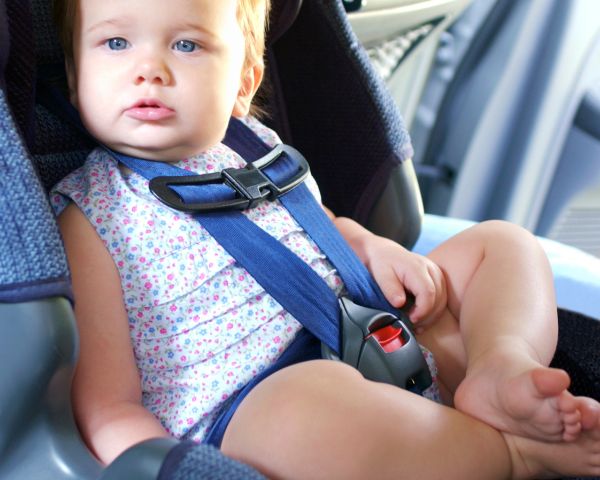
Can You Use a Rear-Facing Car Seat on the Plane?
You can use a rear-facing car seat on a plane if you meet the airline’s requirements. The seat must be approved for air travel as with a forward-facing aircraft seat. The child must also be within the dimension limits so they are the appropriate size and weight to sit in the rear-facing seat safely.
Can You Use Car Seats in Business or First Class?
Most airlines do not allow car seats to be used in Business or First Class. This is usually because the seats are different in on a basic economy fare and the car seat will not secure safely in the same way. This differs between airlines so you can check with yours directly to see their requirements.
Can You Use a Booster Seat On the Plane?
Booster seats are not allowed to be used on planes because booster seats require shoulder and seat belts to provide protection. A booster seat is designed to lift your child up to reach the seat belt of a motor vehicle, but this is not applicable to a plane as it has a lap belt instead. Using a booster seat could have a negative impact if used on a plane and a proper car seat travel system should be used instead. If you are not sure, the car seat will state if it is aircraft travel approved on the label so it is important to check this.
Using the CARES Harness On the Airplane
A CARES harness is designed for older children who can sit upright on their own during the flight. The FAA approves these types of devices are they offer additional security and safety during the flight.
How To Install A CARES Harness
-
Seat the child in their plane seat.
-
Put down the tray table on the seat (the one behind the child).
-
Put the CARES harness over their child’s seat at shoulder height.
-
Tighten the harness around the seat and put the tray table back up.
-
Put the plane seat belt through the harness loops.
-
Secure the child in the arm straps and buckle the belt.
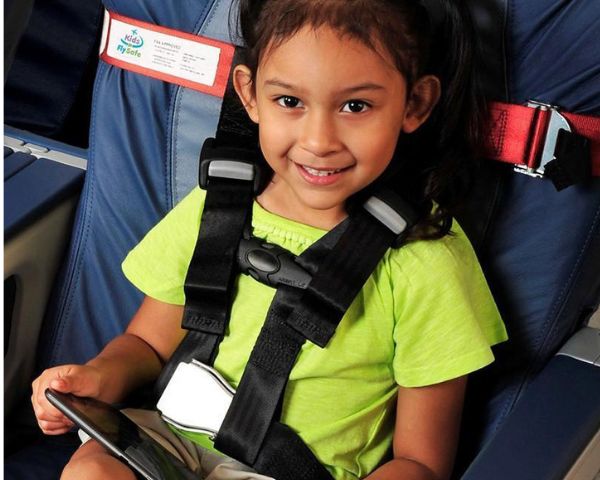
Do I Need To Take My Car Seat?
If your car seat is not suitable for air travel, but you need one at your final destination whilst your child is in the car, consider renting car seats. You can find a rental car and child’s car seat at most car rental companies at the airport so you may not need to worry about bringing your car seat with you. This means you won’t need to worry about your car seat getting damaged or lost, but your child will still be secured during car travel. You can also rent booster seats which are not allowed to be used on the plane.
One thing to note is that renting car seats from rental car companies can be hit and miss. For your peace of mind, you may want to look into companies that specifically hire out baby equipment instead.
Car seats can provide additional safety for your child during the flight. It’s the safest way for them to fly. Not all car seats are suitable for air travel so it is important to check specifically if yours is by looking at the label and certification. Some airlines only allow approved car seats from specific certificates such as the FAA approved car seats so check with your airlines prior to flying.
If you plan on checking in your child’s car seat instead of using it during the flight, be sure to be prepared for any damage by using a protective bag and checking it in at the gate. If you rather check your car seat with your luggage, it is best to check your car seat in its original box secured by padding. If you are able to use a car seat during your flight, ensure you install it correctly so it is secure and safe to use.
If you don’t want to bring your own car seat, consider renting a travel car seat at your final destination. Hope this article gave you some insights into flying with a car seat. At the end of the day, there is no right or wrong about flying or not flying with a car seat. Do what feels right for you.
If you are interested in learning about whether it is safe to fly when pregnant, check out our blog about flying pregnant.




